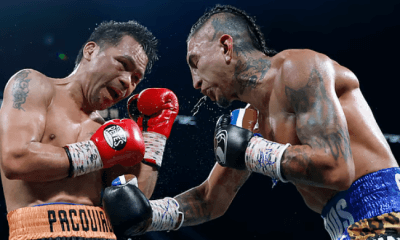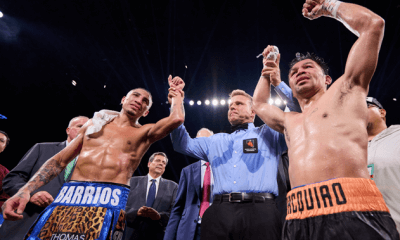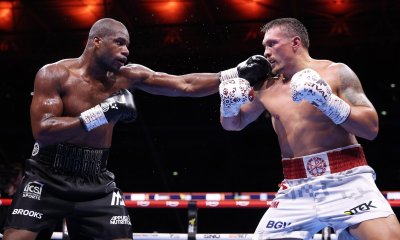Featured Articles
What Our Grandfathers Knew About Joe Louis
 He might not have had the forethought or business acumen to nickname himself “The Greatest,” but Joe Louis was the greatest heavyweight prizefighter who ever lived.
He might not have had the forethought or business acumen to nickname himself “The Greatest,” but Joe Louis was the greatest heavyweight prizefighter who ever lived.
Our grandfathers and great grandfathers knew this well. I wish we did, too.
They saw “The Brown Bomber” put together the most impressive championship reign in the history of the sport. They watched him absolutely demolish an opponent who’d previously bested him by exploiting a soon-corrected flaw of dropping his left lead too low in the most important sporting event there could ever be. They marveled at his unparalleled combination of power, speed and technical precision.
But Joe Louis wasn’t just the best heavyweight they had seen, he was the best heavyweight anyone has seen — ever.
In 2003, Ring magazine praised him as the greatest puncher of all-time. He was devastatingly accurate. He wielded beautifully mechanical combination punches with frightening ease. He elicited songs of praise and adulation like no fighter before or since. There were even a multitude of songs written about him.
Joe Louis never tried to break anyone’s arm or threaten to eat their children, and he didn’t float like a butterfly because he didn’t need to…he was all sting!
I happen to be of the opinion that God made one perfect prizefighter, and that it was Joe Louis. It’s a sentiment shared by many notable boxing historians. Our own resident history buff and TSS expert, Frank Lotierzo, calls Louis “the most faultless heavyweight fighter in history.”
In fact, the International Boxing Research Organization ranks Louis the top heavyweight in history according to its most recently updated member poll posted from March 2005.
Joseph Louis Barrow was born in 1914 in Lafayette, Alabama. He was the seventh of eight children in a family of sharecroppers. In his autobiography, Louis remembered the bareness of the red clay soil – its simplicity.
“You would have thought the whole world was red clay,” he penned.
When he was only two years old, Joe’s father, Munroe Barrow, was committed to an insane asylum. In 1926, his mother remarried a local contractor named Pat Brooks, and the pair moved the family to Detroit in search of a better life.
There, a young Louis took an interest in boxing at the request of a schoolmate. In order to keep his mother off the trail, Joe would sneak his boxing gloves around in a violin case she gave him for music lessons. Instead of making music with his violin, though, Joe made music with his fists, and he quickly earned a reputation as a brilliant fighter. He won fifty of his fifty-four amateur fights and decided to turn pro in 1934 at age twenty.
His professional career took off quickly. He was a paid pugilist for less than a year when he thrashed former champion Primo Carnera in six rounds. He knocked out iron-jawed former champ Max Baer later that year, and was quickly hailed the next great heavyweight champion.
But in 1936 Joe Louis lost to rival and future friend, Max Schmeling. He was hammered repeatedly by right hands from Schmeling who had figured out Louis would leave his left hand too low after delivering his jab. He made him pay for the mistake the entire fight. Louis was knocked out in round twelve after taking just too much punishment.
It was just the lesson he needed.
Two months later, Louis rebounded from the loss by knocking out former champion Jack Sharkey in three rounds. No longer letting his lead hand be lazy, he’d soon become the most dominant force the heavyweight division had ever seen.
Louis won the title in 1937, defeating “Cinderella Man” James J. Braddock in eight rounds. He defended the title three more times until he could get a rematch with Schmeling who, by this time, had become a pawn for Hitler’s Nazi party in Germany.
While Schmeling wasn’t a Nazi, it didn’t really matter. The world saw him in one corner, representing Hitler, fascism and the most vile racism conceivable, and Louis in the other, representing a fierce resistance to the Nazi ideals.
The build-up to the fight was incredible, and it is likely to never be duplicated. Hitler’s “master race” would be on display for the world to see. Schmeling was Nazi Germany’s unwilling hero – an Aryan superman who would prove the merits of their insane paradigm.
Meanwhile, Louis was cast as an American hero simply out of necessity. He embodied the anti-Nazi.
“Joe, we need muscles like yours to beat Germany,” President Roosevelt told Louis before the fight.
If it wasn’t the first time a black man had been rallied behind as symbol of hope and freedom in racially divided America, it was by far the grandest and most galvanizing.
The fight itself turned out to be a mismatch. Hitler telephoned Schmeling moments before the opening bell rang and could have likely stayed on the line long enough to hear his fallen hero return from the ring broken and battered.
Louis pulverized his nemesis in just one round, and with him the perception of Hitler’s strength, knocking him to the canvas three times in brutal fashion. It was vintage Joe Louis. It was the greatest prizefighter who ever lived at his very best in his biggest moment.
Afterwards, when some hailed Louis as “a credit to his race,” one writer profoundly responded, “Yes, Louis is a credit to his race — the human race.”
Recalling the historical significance of the event with boxing historian Larry Schwartz for an ESPN special, “The Brown Bomber’s” son, Joe Louis Jr., praised his father for being a bridge between white and black America.
“What my father did was enable white America to think of him as an American, not as a black,” he said. “By winning, he became white America's first black hero.”
In his prime, Joe Louis was without equal. At his peak, as he was against Schmeling in 1938, Louis was the perfect fighting machine. He had everything a fighter could hope to have, and he was both athletically gifted and technically sound.
Arguably the most dominant champion of any weight class in history, Louis wore the heavyweight crown for almost twelve full years. Even taking two years from his reign to serve his country in World War II, he defended his title twenty-five times before retiring in 1949.
Despite his tremendous success, money problems forced him to come back to the ring in 1950 when he was well beyond his best. He lost a unanimous decision to Ezzard Charles, then reeled off eight straight wins before his final bout, a loss to Rocky Marciano (who was ten years his junior) in 1951.
After his retirement, Louis lived a beleaguered life. He battled family issues, mental illness, drug use and the IRS. In 1981, Louis died at age 66 in Las Vegas, where he had been given a job as a greeter at Caesar’s Palace.
It’s hard to describe the significance of someone like Joe Louis to today’s generation. Louis fought before the information age had taken over the world, and storytellers today only tend to spin yarns for those they can romanticize from their youth. If it were up to them, it seems, we’d only hear the tales of Muhammad Ali and Mike Tyson.
I resist the urge to do this, because I’d rather be a truthful boxing historian than a gifted raconteur. Boxing is more important than that to me, so, as much as I love Evander Holyfield, I try not to oversell his place among the pantheon of greats.
There is no such thing as overselling significance when it comes to Joe Louis.
I once tried to pen something to describe Joe Louis in an adequate manner, and all I came up with was a hodgepodge of words pieced together by others’ remembrances. One cannot capture something like a dream with mere sounds and letters.
Perhaps, though, the story of Joe Louis is best told as succinctly as his punches were against Schmeling in the rematch all those years ago. I found this scribbled about Joe in one of my old journals. It appears to be an attempt at that.
Joe Louis grew up dirt poor and died the same way. In between that, he became the second African American to win the World Heavyweight championship, the first and only person to defend any world title 25 straight times, the quintessential American hero who fought for his country both inside and outside the ring, and possibly the most feared fighter who ever lived.
Rather, if you’re one of those people who only have enough attention span left from your day to keep up with news through twitter (I’m guilty of this myself), here is the TLDR (too long didn’t read) version, too.
-

 Featured Articles3 weeks ago
Featured Articles3 weeks agoThe Hauser Report: Zayas-Garcia, Pacquiao, Usyk, and the NYSAC
-

 Featured Articles2 weeks ago
Featured Articles2 weeks agoOscar Duarte and Regis Prograis Prevail on an Action-Packed Fight Card in Chicago
-

 Featured Articles1 week ago
Featured Articles1 week agoThe Hauser Report: Cinematic and Literary Notes
-

 Book Review5 days ago
Book Review5 days agoMark Kriegel’s New Book About Mike Tyson is a Must-Read
-

 Featured Articles4 weeks ago
Featured Articles4 weeks agoManny Pacquiao and Mario Barrios Fight to a Draw; Fundora stops Tim Tszyu
-

 Featured Articles4 weeks ago
Featured Articles4 weeks agoArne’s Almanac: Pacquiao-Barrios Redux
-

 Featured Articles3 weeks ago
Featured Articles3 weeks agoRemembering Dwight Muhammad Qawi (1953-2025) and his Triumphant Return to Prison
-

 Featured Articles4 weeks ago
Featured Articles4 weeks agoOleksandr Usyk Continues to Amaze; KOs Daniel Dubois in 5 One-Sided Rounds














